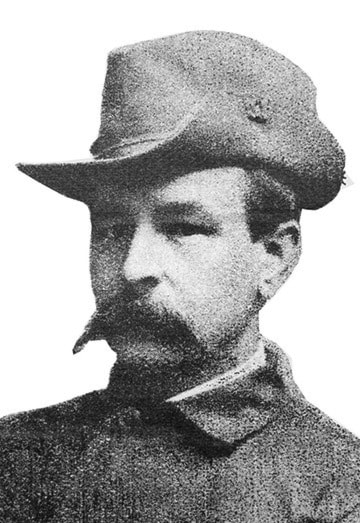Jim Cameron
Janus: Cranbrook Then & Now
Alfred Ernest Watts, born Jan. 21, 1856, in Wellingborough, England, late of Liverpool, came to the East Kootenay in 1897 and spent a brief time in the Fort Steele area before returning home.
A letter written by Mr. Watts to the Fort Steele Prospector newspaper in March, 1898, states: "It may interest you to know that I have formed a development syndicate in London, and a host of people want to come out with me. I am doing my best for the Fort Steele district and East Kootenay ... the collection of specimens I made in the East Kootenay [presumably mineral samples] have been on exhibit in the window of the CPR Co., King William's St., London, and thousands of people have become interested in seeing them. I am sending them by request to Lord Strathcona, the High Commissioner for Canada, who will send them to the School of Mines, then to the Imperial Institute."
Sounds impressive, doesn't it? Well, that's precisely what Mr. Watts intended. If there was a bell to ring then he was the man to pull the rope. A.E. Watts worked tirelessly, made friends and enemies on what appears to be an equal scale and loved to make the news.
Returning to the East Kootenay the following year, he settled a short distance from town; a place he promptly named Wattsburg. He began constructing his community while investing in Cranbrook real estate, buying property opposite the Canadian Pacific Railway station to build a number of small rental houses and a lot on Baker Street, upon which he erected Cranbrook's tallest building of the day, the three-story Watts Block (the building is still there today, sans third storey and now part of The Bedroom series of heritage structures).
The Watts Block played host to businesses, fraternities and, at one point, a public reading room, making it home to the city's first library.
As for Wattsburg itself, Mr. Watts proceeded to create a viable community. He turned from prospecting to lumbering; purchasing the Leask & Slater sawmill in Cranbrook in 1902 and relocating near his townsite. Both the mill and the village grew — a post office and hotel in 1903, a private brewery, orchards, steam-heated greenhouses, animal husbandry — in short, all that was needed to be a self-sustaining village.
There were problems, however, in the eyes of Mr. Watts. The CPR became a constant bone of contention and litigation: forest fires caused by locomotive cinders, rockslides, destruction of public roads and fences. He was a vocal man, a man who wished to be heard.
So, too, did he make literary war against those whom he termed "The Robber Barons of the Mountains", that is to say, the young, yet powerful, local lumber syndicates. They were all against him and the little man trying to earn an honest wage.
"We are not malodorous lawyers, trouble-breeders and parasites," proclaimed a large notice he placed in the local Herald newspaper. "We are not political heelers, hangers-on and sycophants of grasping Railway Corporations after graft and the life blood of the people. We are not dissolute politicians, the residium or spawn of Ottawa ... We give value for money received. We make wood pipes for irrigation ... sashes, doors, furniture ..." and, well, you get the picture.
In hindsight, the beginning of the end for Mr. A.E. Watts and his dreams of a balanced Utopia came in early April, 1909. William Slater of Cranbrook (for whose family Slaterville is named) was doing some contract work at Wattsburg with his 17-year-old son John. It seems the lad developed a casual relationship with Mr. Watts' 14-year-old daughter. Though cautioned by Mr. Watts to stay away from the girl, on the day in question Mrs. Watts approached the stable and witnessed John Slater vacating the same via a window. She found her daughter alone inside, unharmed and, by all accounts, untouched.
The incident enraged Mr. Watts, who immediately held a trial of which it seems only he and the lad were in attendance. Calling upon his powers as a local Justice of the Peace he duly declared the boy guilty and gave him a choice of imprisonment or the lash. Young Slater chose the latter and was immediately ordered to the public square (such as it was) whereupon he was made to grasp a flagpole while Watts himself soundly whipped his back.
Mr. Slater understandably took umbrage with the punishment and sued Mr. Watts for $5,000 in damages on behalf of his son. In May 1909, a special jury in Nelson dismissed the action. The following year Mr. Slater appealed for a new trial. The reviewing judge declared, "The absurdity of the arguments of the defendant [Watts] alleged right to take the law into his own hands [constitutes] a clear case of assault."
Mr. Watts, conducting his own case, failed to convince the new jury who declared in Mr. Slater's favour, awarding him $100 in damages and requiring Mr. Watts to pay all trial costs.
The affair would likely have remained largely unnoticed but for the fact that, immediately following the whipping, Mr. Watts headed directly to the local newspaper office and filed his account of the proceedings with Associated Press which, in turn, sent the news across North America. It proved a minor sensation. When queried as to his intentions Mr. Watts replied that he "sent details for publication for clarification of events among the general public."
Alfred Watts eventually sold his interests in Wattsburg and moved to the Slocan Valley where he spent the remainder of his days in the lumber trade and the rhetoric of politics in his continuing fight against the injustices of the world. He died June 3, 1937, and is buried in the Nelson Memorial Cemetery.
